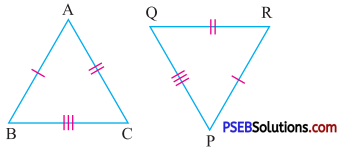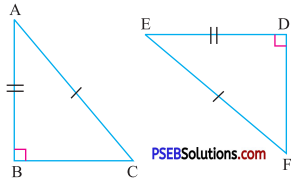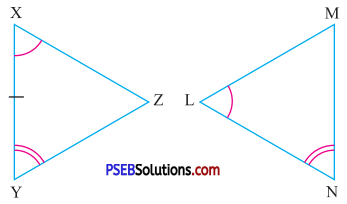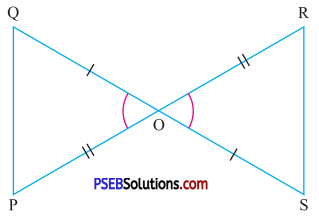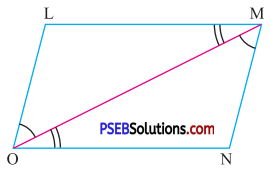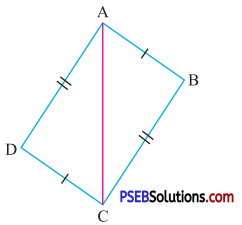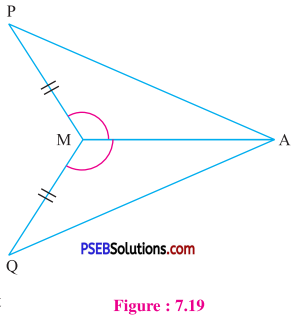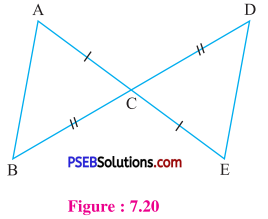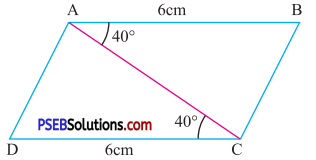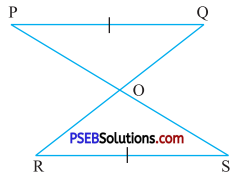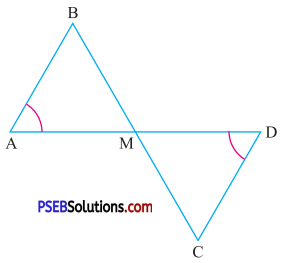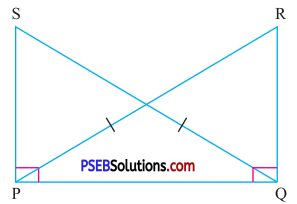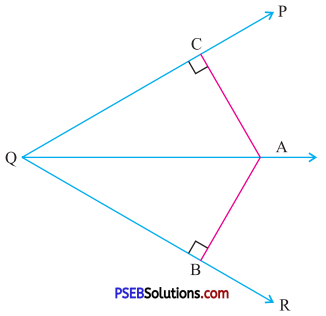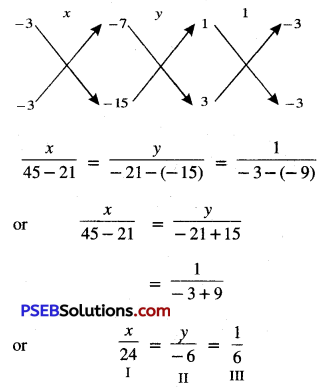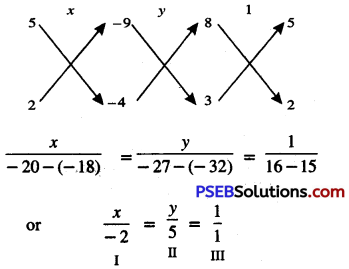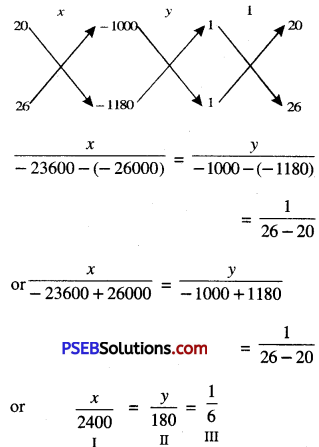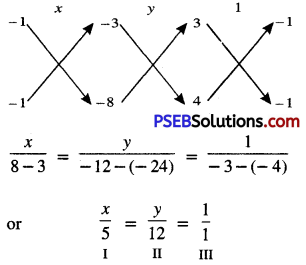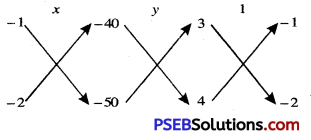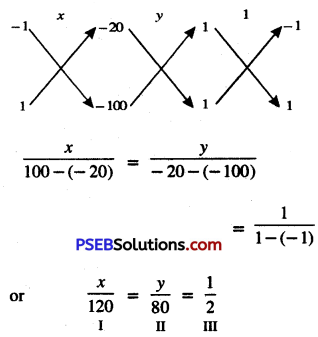Punjab State Board PSEB 9th Class Hindi Book Solutions Hindi Grammar viram chinh विराम चिह्न Exercise Questions and Answers, Notes.
PSEB 9th Class Hindi Grammar विराम चिह्न
निम्नलिखित वाक्यों में सही विराम-चिह्न लगाइए
प्रश्न 1.
भारत वेस्टइंडीज़ के बीच कल.एक दिवसीय मैच खेला गया।
उत्तर:
भारत वैस्टइंडीज के बीच कल एक दिवसीय मैच खेला गया।
प्रश्न 2.
नहीं मैंने ऐसा वायदा कभी नहीं किया।
उत्तर:
नहीं, मैंने ऐसा वायदा कभी नहीं किया।

प्रश्न 3.
अहा मेरे भाई को परीक्षा में प्रथम आने पर छात्रवृत्ति मिली
उत्तर:
अहा ! मेरे भाई को परीक्षा में प्रथम आने पर छात्रवृत्ति मिली।
प्रश्न 4.
साथियो बिना संघर्ष किए हमें कभी सफलता नहीं मिलेगी
उत्तर:
साथियो, बिना संघर्ष किए हमें कभी सफलता नहीं मिलेगी।
प्रश्न 5.
राजा दशरथ के चार पुत्र थे राम लक्ष्मण भरत और शत्रुघ्न
उत्तर:
राजा दशरथ के चार पुत्र थे-राम, लक्ष्मण, भरत और शत्रुघ्न।
प्रश्न 6.
लाला लाजपतराय पंजाब केसरी को कौन नहीं जानता
उत्तर:
लाला लाजपतराय पंजाब केसरी को कौन नहीं जानता?
प्रश्न 7.
माँ प्यार से बेटा चल खाना खा ले
उत्तर:
माँ प्यार से, “बेटा, चल खाना खा ले”।
प्रश्न 8.
सुभाषचन्द्र बोस ने कहा था तुम मुझे खून दो मैं तुम्हें आजादी दूंगा
उत्तर:
सुभाषचन्द्र बोस ने कहा था, “तुम मुझे खून दो मैं तुम्हें आजादी दूंगा”।
प्रश्न 9.
मेरी बहन मास्टर ऑफ़ साइंस एम० एससी० की परीक्षा देने दिल्ली गयी है
उत्तर:
मेरी बहन मास्टर ऑफ़ साइंस (एम० एससी०) की परीक्षा देने दिल्ली गयी है।
प्रश्न 10.
निरंतर काय साधना में लगे रहना ही जीवन है आलस्य तो रोग है
उत्तर:
निरंतर कार्य-साधना में लगे रहना ही जीवन है; आलस्य तो रोग है।
प्रश्न 11.
क्या कहा वह हमारे साथ घूमने नहीं जाएगा
उत्तर:
क्या कहा? वह हमारे साथ घूमने नहीं जाएगा?
प्रश्न 12.
मैंने तो उसे आमंत्रित किया था वह आया ही नहीं
उत्तर:
मैंने तो उसे आमंत्रित किया था, वह आया ही नहीं।
प्रश्न 13.
अध्यापक ने कहा कल समय पर स्कूल आ जाना।
उत्तर:
अध्यापक ने कहा, “कल समय पर स्कूल आ जाना”।
प्रश्न 14.
मेरा क्या नाम है मेरे पिता जी क्या करते हैं मैं कहां रहता हूँ मैं आपको यह सब क्यों बताऊँ
उत्तर:
मेरा क्या नाम है, मेरे पिता जी क्या करते हैं, मैं कहां रहता हूँ-मैं आपको यह सब क्यों बताऊँ?

प्रश्न 15.
हाय राम कैसा अनर्थ हो रहा है
उत्तर:
हाय राम! कैसा अनर्थ हो रहा है?
निम्नलिखित वाक्यों में उचित स्थानों पर विराम चिह्न लगाइए?
(क) कवियों ने उसकी उपमा हीरा मोती माणिक से की है वह बहुत ठीक है वरंच ये अवयव कथित वस्तुओं से भी अधिक मोल के हैं
उत्तर:
कवियों ने इसकी उपमा हीरा, मोती, माणिक से की है वह बहुत ठीक है: वरंच ये अवयव कथित वस्तुओं से भी अधिक मोल के हैं।
(ख) साधारणतः सत्य का अर्थ सच बोलना मात्र ही समझा जाता है लेकिन हमने विशाल अर्थ में सत्य शब्द का प्रयोग किया है विचार में वाणी में और आचार में सत्य का होना ही सत्य है
उत्तर:
साधारणतः सत्य का अर्थ सच बोलना मात्र ही समझा जाता है; लेकिन हमने विशाल अर्थ में सत्य शब्द का प्रयोग किया है विचार में, वाणी में और आचार में सत्य का होना ही सत्य है।
(ग) सत्य की आराधना भक्ति है और भक्ति सिर हथेली पर लेकर चलने का सौदा है अथवा वह हरि का मार्ग है जिसमें कायरता की गुंजाइश नहीं है जिसमें हार नाम की कोई चीज़ है ही नहीं
उत्तर:
सत्य की आराधना भक्ति है और भक्ति ‘सिर हथेली पर लेकर चलने का सौदा’ है अथवा वह ‘हरि का मार्ग’ है, जिसमें कायरता की गुंजाइश नहीं है जिसमें हार नाम की कोई चीज़ है ही नहीं।
निम्नलिखित गद्यांशों को उपयुक्त विराम-चिह्न लगाकर लिखिए
प्रश्न 1.
उसने कहा तुम्हारे लिए कोई मूल्य नहीं है इस कहानी का पर मेरा तो यही सर्वस्व है
उत्तर:
उसने कहा, “तुम्हारे लिए कोई मूल्य नहीं है इस कहानी का! पर मेरा तो यही सर्वस्व है”।
प्रश्न 2.
हे अमृतपुत्रो मृत्यु का भय मिथ्या है कर्त्तव्य में प्रमाद करना पाप है संकोच और दुविधा अभिशाप हैं
उत्तर:
हे अमृतपुत्रो! मृत्यु का भय मिथ्या है। कर्त्तव्य में प्रमाद करना पाप है। संकोच और दुविधा अभिशाप हैं।
प्रश्न 3.
उसने अनुरोध के स्वर में कहा थके मांदे आये कुछ प्रसाद भी नहीं लिया चलो भीतर चलें।
उत्तर:
उसने अनुरोध के स्वर में कहा, “थके मांदे आये। कुछ प्रसाद भी नहीं दिया चलो। भीतर चलें।”
प्रश्न 4.
सवाल के पहले जवाब में उक्ति यदि शब्दशः किसी पर लागू होती है तो बर्नार्ड शॉ पर क्योंकि जिस किसी ने भी शॉ को व्यंग्य में नीचा दिखाना चाहा है उसे खुद ही उनकी हाजिर जवाबी के कारण शर्मिन्दा होना पड़ा
उत्तर:
‘सवाल के पहले जवाब’ में उक्ति शब्दश: किसी पर लागू होती है तो बर्नार्ड शॉ पर क्योंकि जिस किसी ने भी शॉ को व्यंग्य में नीचा दिखाना चाहा है, उसे खुद ही उनकी हाज़िर-जवाबी के कारण शर्मिन्दा होना पड़ा।
प्रश्न 5.
जीवन कर्म क्या है सोचता हूं तो एक ही उत्तर मिलता है शुद्ध जीवन युद्ध है युद्ध से घबराना जीवन से बचना है पर कैसा युद्ध
उत्तर:
‘जीवन कर्म क्या है?’ सोचता हूं तो एक ही उत्तर मिलता है-युद्ध । जीवन युद्ध है। युद्ध से घबराना- जीवन। से बचना है: पर कैसा युद्ध?
प्रश्न 6.
हम महात्मा गांधी के प्रशंसक बने रहकर भी ऐसे काम करते हैं जो लोकतन्त्र सर्वोदय सत्य अहिंसा राष्ट्रीय एवं साम्प्रदायिक एकता आत्म-निर्भरता और स्वदेशी व्रत आदि के विपरीत जाते हैं क्या आप बता सकते हैं कि आजादी के तीस साल बाद भी उनके स्वप्न का रामराज्य क्यों स्थापित नहीं हो सका।
उत्तर:
हम महात्मा गांधी के प्रशंसक बने रहकर भी ऐसे काम करते हैं, जो लोकतन्त्र, सर्वोदय, सत्य, अहिंसा, राष्ट्रीय एवं साम्प्रदायिक एकता, आत्मनिर्भरता और स्वदेशी-व्रत आदि के विपरीत जाते हैं। क्या आप बता सकते हैं कि आजादी के तीस साल बाद भी उनके स्वप्न का रामराज्य क्यों स्थापित नहीं हो सका?

निम्नलिखित वाक्यों में विराम-चिह्न लगाइए
1. राम कृष्ण मोहन और हरि एक ही कक्षा के विद्यार्थी हैं
2. हँसो गाओ और खुश रहो
3. सवेरे उठता हूँ स्नान करता हूँ कपड़े पहनता हूँ और स्कूल चला जाता हूँ
4. मोहन मेरी बात तो सुनो
5. हे ईश्वर दया करो
6. काला कोट जो तुमने पहन रखा है बहुत सुन्दर है
7. हाँ मैं अवश्य तुम्हारा साथ दूंगा
8. मैं बीमार हूँ इसलिए विद्यालय नहीं जा सकता
9. प्रत्येक मनुष्य को चाहे वह दुखी है या सुखी भगवान् को याद रखना चाहिए
10. मैं तुम्हें रुपए दे देता किन्तु मेरी तो अपनी जेब खाली है
11. मोहन लड़ाकू है जबकि सोहन पढ़ाकू
12. जब हम स्टेशन पहुँचे गाड़ी जा चुकी थी।
13. मुझे आशा है तुम पास हो जाओगे
14. सदा सच बोलो
15. परिश्रम करो सफलता तुम्हारे कदम चूमेगी
16. तुम्हारा क्या हाल है
17. हूँ मैं उस बेवकूफ के पास बै
18. भारत हमारा देश है हमें प्राणों से भी प्यारा है
19. 15 अगस्त सन् 1947 को भारत स्वाधीन हुआ था
20. अध्यापक ने कहा बच्चो पृथ्वी गोल है
21. कपड़े भी बदलने हैं रोटी भी खानी है साइकिल भी ठीक करवानी है दस मिनट में यह सब कैसे हो सकता
22. मोहन ने कहा हम तुम्हारे साथ हैं
23. ओहो बेचारा गरीब मारा गया
24. नेता जी ने कहा तुम मुझे खून दो मैं तुम्हें आजादी दूंगा
25. राजा दशरथ के चार पुत्र थे राम भरत लक्ष्मण और शत्रुघ्न
26. ओ बेटे शरारतें न करो
प्रश्न 1.
‘विराम चिह्न’ से क्या तात्पर्य है?
उत्तर:
‘विराम’ का शाब्दिक अर्थ ‘रुकना’, ठहराव अथवा विश्राम है। जैसे हमें जीवन में कार्य करते हुए थक जाने पर विश्राम की आवश्यकता होती है, उसी प्रकार से जब हम सोचते और लिखते हैं तो इस सोचने और लिखने में आने वाले अंतर को हम विराम चिहनों द्वारा व्यक्त करते हैं क्योंकि इन के प्रयोग से ही हमारा आशय स्पष्ट होता है; जैसे किसी भागने वालों को मारने के लिए हम कहते हैं- “रोको मत, मारो।” इसी वाक्य को यदि ऐसे लिखा जाए “रोको, मत मारो’ तो हमारे कथन का अर्थ ही बदल जाएगा। यहाँ विराम चिह्नों के प्रयोग से ही वक्ता का मत व्यक्त होता है। इनके प्रयोग से वक्ता की बात को सरलता से समझा जा सकता है।
प्रश्न 2.
‘विराम-चिह्न’ की परिभाषा लिखिए।
उत्तर:
किसी वाक्य में भावों की स्पष्टता के लिए रुकना विराम कहलाता है तथा इस विराम को व्यक्त करने के लिए जिन चिह्नों का प्रयोग करते हैं, वे विराम चिह्न कहलाते हैं।
हिन्दी में प्रयुक्त विराम चिह्न
| नाम |
चिह्न |
| 1. अल्प विराम |
, |
| 2. अर्द्ध-विराम |
; |
| 3. पूर्ण-विराम |
। |
| 4. योजक |
– |
| 5. प्रश्नवाचक चिह्न |
? |
| 6. विस्मयादिबोधक चिहन |
! |
| 7. उद्धरण अथवा अवतरण चिह्न |
“ “ |
| 8. कोष्ठक चिह्न |
(), {}, [] |
| 9. विवरण चिह्न |
:- |
| 10. अपूर्ण विराम |
: |
| 11. निर्देशक चिह्न |
_ |
| 12. हँसपद या त्रुटिबोधक चिह्न |
^ |
| 13. लाघव चिहन |
° |
| 14. तुल्यतासूचक चिह्न |
= |
| 15. समाप्तिबोधक चिह्न |
…………. ………….. …………. |
| 16. पुनरुक्तिबोधक चिह्न |
“ “ “ |
1. अल्प-विराम (,) – अल्प-विराम का अर्थ है, थोड़ी देर के लिए रुकना या ठहरना। इसका प्रयोग प्राय: दो शब्दों, पदों या वाक्यांशों के बीच होता है।
(क) जब पढ़ते, बोलते या लिखते समय अल्प समय के लिए रुकना पड़े, वहां इस अल्प विराम का प्रयोग होता है। उदाहरण के लिए-राम, लक्ष्मण, भरत, शत्रुघ्न ये चारों भाई थे।
(ख) जब एक ही प्रकार के वाक्यांश पास-पास लिखे जाएं तब अल्प-विराम का प्रयोग होता है। जैसे-
- रीमा रोज़ आती है, पढ़ती है और चली जाती है।
- गाँधी जी हरिश्चन्द्र के समान सत्यवादी, श्रीकृष्ण के समान नीतिज्ञ और महात्मा बुद्ध के समान अहिंसावादी थे।
(ग) आश्रित वाक्यों को अलग करने के लिए अल्प-विराम का प्रयोग होता है। जैसे-
- आज मैं काम पर नहीं जाऊंगा, क्योंकि मैं बीमार हूं।
- मैं बीमार हूँ, इसलिए काम पर नहीं जा सकता।
- मैं तुम्हें पाँच सौ रुपये दे देता, किन्तु मेरी तो अपनी जेब खाली है।

(घ) सम्बोधन के बाद भी प्रायः अल्प-विराम का प्रयोग होता है। जैसे-
- सज्जनो, समय आ गया है, सावधान हो जाओ।
- हे ईश्वर, दया करो।
- राघव, मेरी बात सुनो।
- साथियो, देश तुम्हें पुकार रहा है।
(ङ) उपाधियों को अलग-अलग दिखाने के लिए अल्प-विराम का प्रयोग होता है। जैसे-
- बी० ए०, एम० ए०, पी-एच० डी०, डी० लिट।
- एम० बी० बी० एस०, एम० डी०, डी० एम०, एम० सी-एच०।
- बी० ए०, एल० एल० बी०, एल० एल० एम०।
(च) उद्धरण से पहले अल्प-विराम प्रयुक्त होता है। जैसे-
- मोहित बोला, “अब भागा जाए।”
- साधना हँसते हुए बोली, “तब क्या होगा?”
(छ) एक ही शब्द या वाक्यांश को दोहराने के लिए अल्प-विराम का प्रयोग होता है। जैसे-
- बैठो, बैठो, गुरु जी आ रहे हैं।
- भागो, भागो, पागल कुत्ता इधर ही आ रहा है।
(ज) शब्द युग्मों को अलग करने के लिए अल्प-विराम का प्रयोग होता है। जैसेगरीब और अमीर, छोटे और बड़े, दुबले और पतले, लम्बे और छोटे, बूढे और जवान-सब डर के मारे काँप उठे थे।
(झ) पत्र में अभिवादन, समापन आदि में अल्प-विराम का प्रयोग होता है. जैसे-
- पूज्य पिता जी, प्रिय भाई, आदरणीय दादा जी, महोदय, प्रियवर आदि।
- आपका, भवदीय, शुभेच्छु आदि।
(ञ) तब, वह, कभी-कभी, तो आदि के स्थान पर अल्प-विराम प्रयुक्त होता है जैसे-
- जब हम एयरपोर्ट पहुँचे, फ्लाइट जा चुकी थी।
- तब, जब हम घर पहुँचे, आंधी आरम्भ हो चुकी थी।
2. अर्द्ध विराम (;)- जहाँ समान आधार वाले लम्बे वाक्यों को अथवा विरोधपूर्ण कथनों को अलग करने की आवश्यकता हो और जहाँ अल्प-विराम की अपेक्षा कुछ अधिक ठहरना पड़े, वहाँ अर्द्ध-विराम का प्रयोग होता है। जैसे
व्याकरण
- प्रधानमन्त्री अमृतसर आए; प्रभावशाली भाषण दिया; लोगों की श्रद्धा उमड़ पड़ी।
- (i) चाँद चमक रहा था; चाँदनी छिटकी हुई थी; मैं आकाश की ओर निहार रहा था।
- कपड़े प्रेस करने हैं; दूध गर्म करना है; सब्जी लानी है, आधे घंटे में यह सब कुछ नहीं हो सकता।
- चंद्रशेखर आजाद नहीं रहे, वे अमर हो गये।
- छोटे-छोटे बच्चे पानी में घुस जाते हैं; पानी उछालते हैं; तरंगों से खेलते हैं।
- कपड़े भी बदलने हैं; रोटी भी खानी है; साइकिल भी ठीक करवाना है; दस मिनट में यह कैसा हो सकता है।
3. पूर्ण-विराम (।)- पूर्ण-विराम का अर्थ है, पूरी तरह रुकना या ठहरना। प्रश्नवाचक और विस्मयादिवाचक वाक्यों को छोड़कर जहाँ एक वाक्य अपने पूर्ण अर्थ को प्रकट कर समाप्त हो जाता है, वहां पूर्ण विराम का प्रयोग होता है। जैसे-
- सदा सच बोलो।
- परिश्रम करो, सफलता तुम्हारे कदम चूमेगी।
- मैं आज ही देहली से आया हूँ।
- वह आठवीं कक्षा में पढ़ता है।
- वीना सुबह मंदिर जाती है।
4. योजक-चिह्न (-)- योजक-चिह्न प्रायः दो शब्दों को जोड़ता है। इसका सर्वाधिक प्रयोग समस्त पदों में होता है। और भी अनेक प्रकार से इस चिह्न का प्रयोग होता है। जैसे-
- माता-पिता, घर-द्वार, सीता-राम, नर-नारी।
- लेन-देन, रात-दिन, आकाश-पाताल, जन्म-मरण।
- मान-मर्यादा, भोग-विलास, सूझ-बूझ, चमक-दमक, जी-जान।
- लूला-लंगड़ा, अंधा-बहरा, भूखा-प्यासा।।
- आत्मा-परमात्मा, अनाप-शनाप, झूठ-मूठ, पानी-वानी।
- पढ़ना-लिखना, उठना-बैठना, कहना-सुनना, रहना-सहना।
- गली-गली, नगर-नगर, शहर-शहर, गाँव-गाँव, बच्चा-बच्चा।
- चलना-चलवाना, डराना-डरवाना।
- उड़ना-उड़ाना, गिरना-गिराना।
- ग़रीब-सा, सीधी-सी, मरियल-सा।

5. प्रश्नवाचक चिह्न (?)- यह चिह्न प्रश्नवाचक वाक्य के अन्त में लगाया जाता है। जैसे-
- क्या तुम देहली जाओगे?
- तुम्हारा क्या हाल है?
- जहां. भ्रष्टाचार का बोलबाला है, वहां ईमानदारी कैसे टिक सकती है?
- आपका क्या नाम है?
- तुम्हारा घर कहाँ है?
(क) प्रश्न का चिह्न ऐसे वाक्यों में नहीं लगाया जाता जिनमें प्रश्न-आज्ञा के रूप में हो। जैसे-कलकत्ता (कोलकाता) का प्रसिद्ध बाज़ार बताओ।
(ख) जिन वाक्यों में प्रश्नवाचक शब्दों का अर्थ सम्बन्धवाचक शब्दों का सा होता है, उनमें प्रश्न-चिह्न नहीं लगाया जाता। जैसे-
- आपने क्या कहा, सो मैंने नहीं सुना।
- वह नहीं जानता कि मैं क्या चाहता हूँ।
किसी व्यंग्य के भाव को प्रकट करने के लिए भी प्रश्न-चिह्न का प्रयोग करते हैं। जैसे-
तुम नेताओं की ईमानदारी पर उंगली उठाई जा सकती है?
6. विस्मयादिबोधक चिहन (!)- (क) जहां आश्चर्य, शोक, भय, हर्ष, घृणा, विस्मयादिबोधक मन के भाव प्रकट हों, वहां इस चिह्न का प्रयोग होता है। जैसे-
- अहा ! कितना मनोरम दृश्य है!
- ओहो! बेचारा गरीब तो मारा गया।
- वाह! तुम ने तो कमाल कर दिया।
- उफ़! कितना दर्दनाक हादसा है।
- हैं! वह निकक्मा कक्षा में प्रथम आया है।
- हाय! उसके पिता का स्वर्गवास हो गया। बढ़ता हुआ मनोविकार सूचित करने के लिए दो अथवा तीन आश्चर्य चिहनों का प्रयोग किया जाता है। जैसेशोक! शोक!! महाशोक!!!
7. उद्धरण चिह्न (” “)- (क) जहां किसी पुस्तक का कोई वाक्य या अवतरण ज्यों का त्यों उद्धृत किया जाए वहां इस चिह्न का प्रयोग होता है। (ख) पुस्तक, समाचार-पत्र, लेखक अथवा कवि का उपनाम, लेख का शीर्षक आदि उद्धृत करते समय भी इकहरे उद्धरण चिह्न का प्रयोग होता है। जैसे-
- ‘कुरुक्षेत्र’ के रचयिता रामधारी सिंह ‘दिनकर’ हैं।
- इनका सारा शरीर ऐसे लचकता है, जैसे अंग्रेजी कानून’।
- प्रस्तुत पंक्तियाँ ‘टूटते परिवेश’ शीर्षक एकांकी से ली गई हैं।
- नेता जी ने कहा था–“तुम मुझे खून दो, मैं तुम्हें आजादी दूंगा।”
- जयशंकर प्रसाद जी के प्रमुख नाटक हैं- ‘चन्द्रगुप्त’, ‘स्कन्दगुप्त’, ‘ध्रुवस्वामिनी’।
- अध्यापक जी ने कहा- “कल अवकाश रहेगा।”
8. कोष्ठक चिह्न [], (), { }- वाक्य में आए किसी पद विशेष को भली-भान्ति स्पष्ट करने के लिए कोष्ठकों । का प्रयोग होता है। जैसे-
- प्रधानमन्त्री (श्रीमती इन्दिरा गांधी) एक आदर्श नेता थीं।
- राष्ट्रपिता (महात्मा गांधी) सत्य और अहिंसा के पुजारी थे।
- धर्मराज (युधिष्ठिर) सत्य और धर्म के रक्षक थे।
- इन्द्र (आनन्द से) अच्छा मैं सफल हो गया।
- चाचा जी (जवाहरलाल नेहरू) बच्चों से बहुत प्यार करते थे।
- रामस्वरूप (शंकर से)-चाय और लीजिए।
9.निर्देशक/डैश (-)- (क) निर्देशक का प्रयोग नाटक के वार्तालाप में प्रायः प्रस्तुत किया जाता है। जैसे-
(i) राजेश-अब हमारा तुम्हारा साथ नहीं निभ सकता।
सलोनी-क्यों? ऐसा क्या हो गया ?
(ii) अध्यापक-बाहर निकल जाओ, तुम।
विद्यार्थी-क्षमा कीजिए, आगे से ऐसा नहीं होगा।
(ख) निक्षिप्त पदों के आगे और पीछे निर्देशक का प्रयोग किया जाता है। जैसे-
- प्रयोगवादी काव्यधारा के प्रवर्तक-अज्ञेय-ने नये शिल्प को अपनाया।
- छायावादी कवयित्री-महादेवी वर्मा-कोमल भावों से परिपूर्ण थीं।
(ग) जैसे, तैसे, यथा, कहना, बोलना आदि के बाद निर्देशक का प्रयोग होता है। जैसे-
- पूनम बोली-अरे, कभी सुन भी लिया करो।
- नूतन ने कहा-अच्छा सुनाओ।
10. विवरण चिह्न (:-)- किसी पद की व्याख्या करने या किसी के बारे में विस्तार से कुछ कहने के लिए जिस चिह्न का प्रयोग होता है, उसे विवरण कहते हैं। जैसे-
- मैं कई बार देहली जा चुका हूं, पाठकों की जानकारी के लिए कुछ विवरण यहां लिख रहा हूं
- पाठ का सार. इस प्रकार है
- राम के चरित्र की निम्नलिखित विशेषताएँ हैं:
11. अपूर्णता सूचक (× × ×)- किसी लेख में जब अनावश्यक अंश छोड़ दिया जाता है, तब उसके स्थान पर इस चिह्न का प्रयोग किया जाता है।

12. हंस-पद (^)- लिखने में जब कोई शब्द भूल से छूट जाता है तब उसे पंक्ति के ऊपर लिख देते हैं। यह चिह्न उसकी पूर्ति का सूचक होता है। जैसे-
- कवि में जन्मजात प्रतिभा होती है।
- हमें उचित मार्ग अपनाना चाहिए।
13. लाघव चिह्न (०)- समय की बचत अथवा पुनरुक्ति के निवारण के लिए। किसी संज्ञा को संक्षेप में लिखने के निमित्त इस चिह्न का उपयोग करते हैं। जैसे-पं० (पंडित), डॉ० (डॉक्टर), सी० आई० डी०, सी० पी०।।
14. तुल्य-सूचक चिह्न ( = ) शब्दार्थ अथवा गणित की तुल्यता सूचित करने के लिए इस चिह्न का प्रयोग किया जाता है, जैसे सुशिक्षित = भली भान्ति पढ़ा-लिखा। दो और दो = चार। विद्या + आलय = विद्यालय।
15. स्थान पूरक (…..)- यह चिह्न सूचियों में खाली स्थान भरने के काम आता है। ‘जूही की कली’ कविता के रचयिता …….. हैं।
16. समाप्ति सूचक चिह्न (-×-)- इस चिह्न का उपयोग बहुधा लेख अथवा पुस्तक के अन्त में होता है।
17. पुरुक्ति बोधक चिह्न (” ” “)- जहाँ ऊपर लिखी बातों अथवा वाक्य या वाक्यांश को पुनः नीचे लिखना हो वहाँ इस चिह्न का प्रयोग होता है, जैसे-
- यह अंश पुस्तक के पृष्ठ 12 से लिया गया है।
- ” ” ” ” ” “42” ” ” ” ” “
![]()

